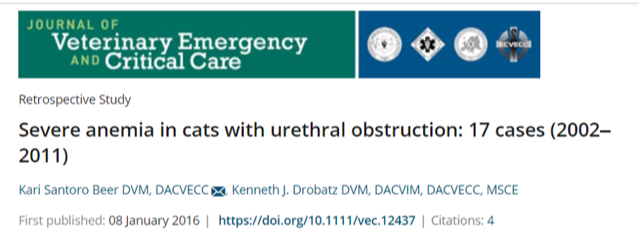Aim to report clinical presentation of cats with urethral obstruction (UO) and severe anaemia (UO-A) and to describe the clinical parameters, risk factors and outcome.
Review of medical records of cats with urethral obstruction and anaemia
Severe anaemia with need for transfusion <20% with Clinical Signs attributed to anaemia (tachycardia, hypotension, tachypnoea, prolonged CRT)
Exclusions included incomplete medical record, mild anaemia (>20) or anaemia attributed to another cause
Unmatched controls 30 cats with UO and mild to no anaemia was randomly selected
Treatments administered were at the clinician’s discretion.
Survivors if they were discharged alive from the hospital and non survivors if they died or were euthanized
During the period of the study, 2132 cats were treated for urethral obstruction at our institution with 17 UO-A cases during this period this equates to an incidence of 0.8%
Signalment of UO-A: Median age - 3.8 years, DSH 16/17, 16/17 MN
Cases in UO-A group were more likely to have experience a previous obstruction 65% vs 27% in control group
UO-A cases had a significantly longer duration of CSX median 3 days compared to UO controls of 1 day
UO-A more likely to have gallop or murmur and statistically significant lower MAP
Median PCV 28% for UO-a compared to 44 UO, with 7 of the UO-A cats having PCV <20 at presentation and all had a PCV <20 at time of transfusion. 3 cats did not receive a transfusion despite PCV <20%. 2 were euthanised prior to transfusion and 1 cats with PCV of 18 survived.
TP, PCO2, K, lactate was not significantly different
UO-A cats had a significantly higher BUN and crea conc, lower pH and more negative base excess and lower PCV
UO-A 24x more likely to have grossly bloody urine
Length of hospitalisation was not significantly longer with UO-A group but did have a significantly longer duration of U catheter
All UO obstruction cats survived to discharge compared to 76.5% in UO-A cats (all euthanised)
Discussion
Cats were presumed to have haemorrhage into the urinary bladder as the cause of the severe anaemia.
Cases in this study UO-A group 11/17 (65%) were more likely to have been previously obstructed - contradicts another study by Lee et al J. Vet Emerg. Crit care 2006; 16(2): 104-111
Possible causes for UO-A; significantly longer duration of clinical signs compared to UO controls. Likely that prolonged bladder wall pressure could cause more significant mucosal injury and haemorrhage.
UO-A cases more metabolically compromised. In severe uraemia and acid base changes have been reported to contribute to platelet function abnormalities including impairment of platelet-platelet and platelet - vessel wall interactions. These factors combined with more severe bladder mucosal injury due to previous obstruction and longer duration of clinical signs these may be additive risk factors for haemorrhage.
Length hospitalization was not significantly different between UO-A and UO groups indicating that once hydration and anaemia corrected the cats stabilize quickly.
The findings that urinary catheterization was longer in UO-A cats is not surprising as most clinicians leave U cath in place until urine is grossly clear.
Mortality greater in UO-A cats 23.5% . Cases much higher than in previous reports of cats with UO in which mortality ranged from 5.8% to 8.9%
Limitations
Retrospective and Small sample size








